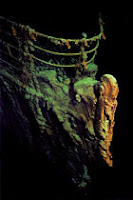
I was interested to read a recent article by William Broad in the Science section of the New York Times entitled "In Weak Rivets, A Possible Key to Titanic's Doom". The article summarized investigations by historians of science who have looked into the question of whether Harland and Wolff, builders of the Titantic and her two sister ships Olympic and Britannic, used sub-standard rivets on the Titanic (see my previous post about these ships). Deep submersibles investigating the Titanic's wreck site have seen that the plates in the forward part of the ship's plates sprung open from the impact with the iceberg. The bow and stern of the ship were put together with iron rivets while the center, higher-stressed, portion of the hull was riveted using stronger steel rivets. The evidence seems to suggest that poor quality material and poor riveting techniques lead to brittle rivets which fractured more easily when the ship hit the iceberg.
What caught my eye in the article was a description of the riveter's art:
In their research, the scientists, who are metallurgists, found that good riveting took great skill. The iron had to be heated to a precise cherry red color and beaten by the right combination of hammer blows. Mediocre work could hide problems.
This really speaks to my blog of a couple of days ago about defining what is technology? The Greeks would have easily called the art of riveting "techne". It was something that took a highly skilled and experienced worker to do correctly. Done right using good material, iron rivets were perfectly acceptable fasteners. But done poorly (the builder couldn't find enough qualified riveters for the massive project) and with inferior materials (the iron ordered was often of a lower grade), then the integrity of the rivets were very much in question.
The article went on to describe how iron gave way to steel in later riveted construction and hand riveters were upgraded with automatic riveting equipment to insure more consistent results. Certainly, these were steps in the right direction to insure the safety of structures. But somewhere along the way, another art died, the art of the hand riveter. We probably don't need many of them anymore but it is a great example of how so many other artisans have disappeared to progress. Stone masons, wood carvers, glass makers, steel workers, these occupations and more have become part of the "lost arts", part of the "lost techne". TItanic was lost for the lack of techne.
No comments:
Post a Comment